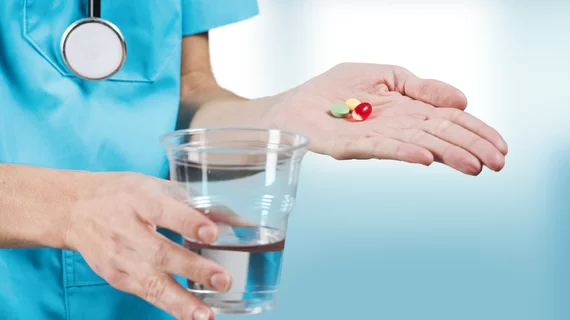Anticoagulants ‘not useful at all’ in TAVR patients who don’t require them
Primary results from the GALILEO trial, presented at the American Heart Association’s annual meeting this November, suggest patients undergoing transcatheter aortic valve replacement (TAVR) with no ongoing indication for oral anticoagulation benefit more from an antiplatelet-based treatment approach than a rivaroxaban-based approach.
GALILEO (Global Comparison of a Rivaroxaban-Based Antithrombotic Strategy versus an Antiplatelet-Based Strategy After Trancatheter Aortic Valve Replacement to Optimize Clinical Outcomes) was launched by Yuvraj Singh Chowdhury, MD, and colleagues in an attempt to evaluate the efficacy and safety of rivaroxaban versus antiplatelets in patients who’d just undergone TAVR. A total of 1,644 individuals across 136 centers in 16 countries were enrolled in the randomized controlled trial.
Chowdhury et al. considered a primary composite efficacy endpoint of time to all-cause death, stroke, MI or thromboembolic events and a primary composite safety endpoint of major, disabling or life-threatening events. Within a week of undergoing TAVR, study participants with no ongoing indication for oral anticoagulation were randomized to one of two medication regimens:
- 10 mg rivaroxaban plus 75-100 mg ASA once daily for 90 days, followed by rivaroxaban alone
- 75 mg clopidogrel plus 75-100 mg ASA once daily for 90 days, followed by clopidogrel alone
GALILEO was stopped early, in August of 2018, due to safety concerns from the Data and Safety Monitoring Board. At the time the trial had randomized 826 patients to its rivaroxaban group and 818 patients to the antiplatelet group, and there were clear disadvantages to the rivaroxaban-based approach. Just 183 patients had reached the primary efficacy outcome by the time the study was terminated.
Chowdhury and colleagues reported that in patients without an indication for oral anticoagulation after TAVR, 10 mg daily of a rivaroxaban-based antithrombotic therapy was associated with a higher risk of death, thromboembolic events and bleeding compared to an antiplatelet-based strategy. The higher number of deaths in the rivaroxaban group couldn’t be attributed solely to higher bleeding rates in that arm, so the authors posited the increased mortality rate in rivaroxaban-treated patients was the result of more sudden, unexplained and non-CV deaths in the population.
The researchers said a new set of trials will be needed to compare different antiplatelet drugs among TAVR patients who don’t require anticoagulation after their procedure. In an AHA summary, GALILEO researchers said their findings indicate that the use of anticoagulants after TAVR “is not useful at all in patients who do not have any specific indication for such treatment.”
“There is no need to routinely use anticoagulation with rivaroxaban after TAVR if another specific indication for this type of medical therapy is absent,” the summary reads. “The findings from this trial supersede any possible benefit of routine anticoagulation with rivaroxaban in ‘clearing up’ valve leaflets from any clotting as suggested from valve imaging studies.”

